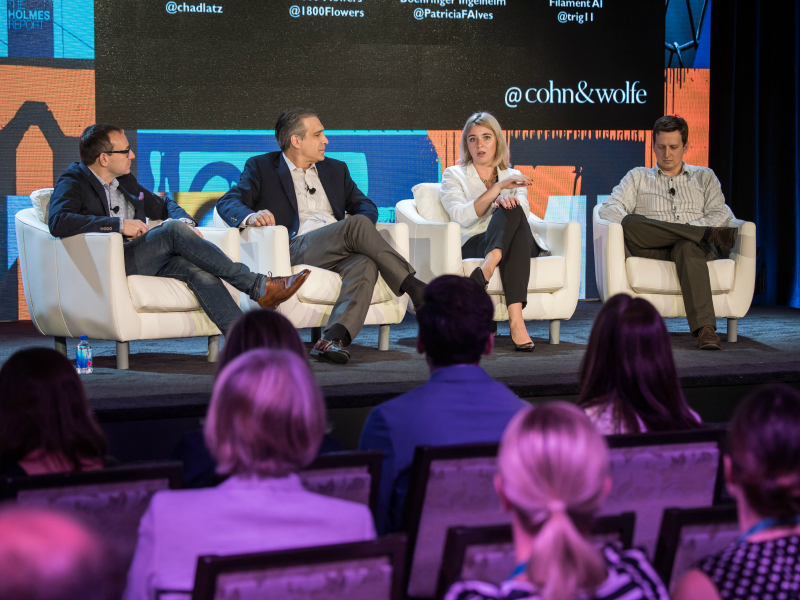Diana Marszalek 24 Oct 2017 // 6:46PM GMT

MIAMI— At a time when Siri and Alexa are household names, the way brands are increasingly launching artificial intelligence capabilities — i.e. “chat bots” — of their own, was among the topics discussed during sessions about next-gen capabilities at PRovoke17 in Miami today.
A session, sponsored and moderated by Cohn & Wolfe, explored how and when to use AI to market brands.
“We see conversational commerce as the next generation of ways for our customers to find gifts for people and have a seamless experience,” said Tony Chivari, 1-800-Flowers senior VP of enterprise market and customer insights.
Roughly 18 months ago, the company was propelled into that new era with the launch of “GWYN (an acronym for Gifts When You Need),” the “friendly” bot that lives on 1-800-Flowers digital platforms to guide users purchases. And, like many other consumer bots, GWYN has a female persona.
“The research says that consumers tend to feel that females are more helpful, more trustworthy and more engaging,” Chivari said, adding that GWYN also serves a largely female customer base.
Like the bulk of brands using early-stage bots, 1-800-Flowers is still toying with the technology, learning its capabilities, how to maximize its customer interactions – and what it can’t do, like helping consumers choose a gift that’s more appropriate as a show of sympathy than, say, a birthday celebration. Therefore, limiting the bot’s offerings so that it doesn’t steer customers wrong is key, Chivari said.
“You want to have interactions that you feel confident are going to be positive,” he said.
Patricia Alves, the pharmaceutical company Boehringer Ingelheim’s global manager of social engagement, said avoiding pitfalls is one of the primary reasons why it’s incumbent on not pushing the use of bots beyond their capabilities – and making it clear to consumers that they they are indeed talking to artificial intelligence, not a real-life human.
In turn, the ultimate aim of Boehringer Ingelheim’s bot Tabatha (named for the matronly English woman her creators imagine her as) is to create a dialogue with people suffering from asthma to identify symptoms and motivate them to speak to their doctor.. And if they don’t follow up, Tabatha will remind them.
“We want to inform them that if they are having asthma symptoms, they should change or adapt their treatment,” Alves said. “We don’t feel in this situation we should be talking to patients further than what the bot offers.”
Andy Feltham, Filament’s technical director, said he expects next-level bot capabilities to quickly ramp up – so much so that within the next couple of years the GWYNs and Tabathas of world will be doing more than just talking.
“What I’d like to see is (bots) becoming more of a conversational agent, a digital assistant.” That would enable bots to complete transactions, like purchases, that don’t need a human touch he said.
“Once you start purchasing the next thing will be interacting,” Feltham said. “It’s more about where we want to take this more than what the technology is capable of doing.”
A separate session exploring the future of connected healthcare, moderated and sponsored by Ruder Finn, reflected on the challenges and opportunities at the intersection of digital and healthcare.
Ogi Kavazovic, Flatiron Health CMO/SVP of product strategy, noted the inherent tension embedded in connected health — fast-paced technologists joining forces with more cautious clinicians. This leads to processes being created “as we go” and “coming up with compromises every week.”
To cross-pollinate between these two mindsets, Flatiron requires employees to shadow clinicians, and conversely, for oncologists to participate in hackathons.
GE Healthcare CMO Sarah Wills emphasized there’s a “massive interest” from patients, customers and especially the media on proof points that demonstrate ways connected healthcare is changing outcomes for patients and systems.
“Patients are open to telling these stories,” she said. “The bigger challenge is customers.”
Meanwhile, Kavazovic noted that a lesser known story is how the availability of cloud data in healthcare is a dramatic change. Citing “a massive IT crisis in healthcare,” he points out that only five years ago data was mostly stored locally.
“Now we have the data and things that used to take years can be done in seconds,” he said.
Michael Schubert, Ruder Finn chief innovation officer, moderated the session.
Aarti Shah contributed to this report.


































.jpg)


















